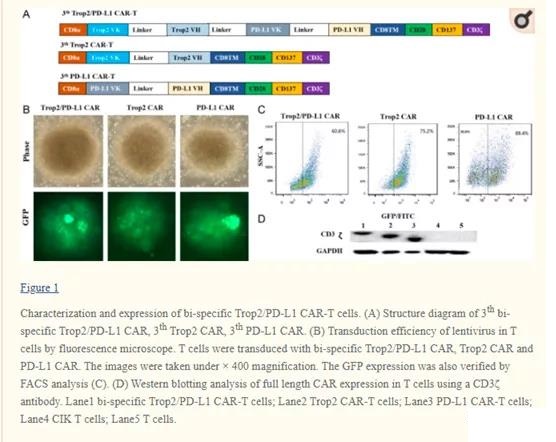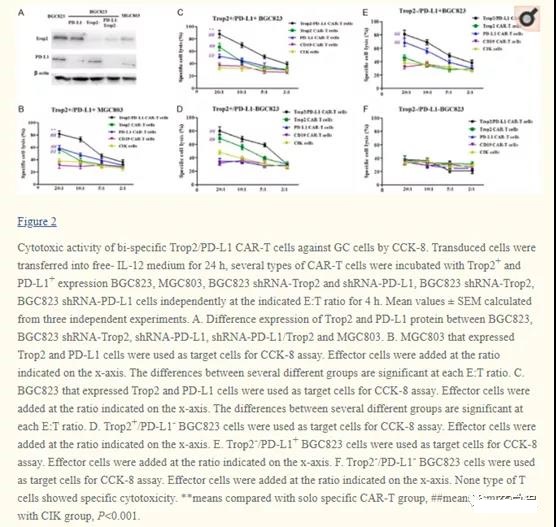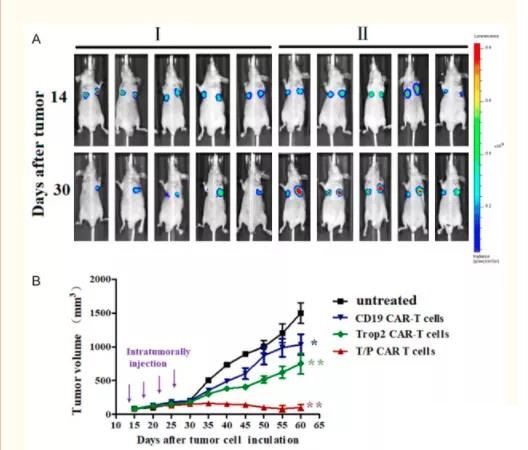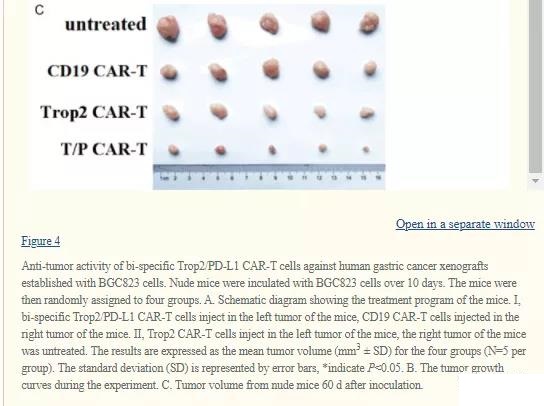A new bispecific Trop2/PD-L1 CAR-T cell targeting gastric cancer
- Normal Liver Cells Found to Promote Cancer Metastasis to the Liver
- Nearly 80% Complete Remission: Breakthrough in ADC Anti-Tumor Treatment
- Vaccination Against Common Diseases May Prevent Dementia!
- New Alzheimer’s Disease (AD) Diagnosis and Staging Criteria
- Breakthrough in Alzheimer’s Disease: New Nasal Spray Halts Cognitive Decline by Targeting Toxic Protein
- Can the Tap Water at the Paris Olympics be Drunk Directly?
A new bispecific Trop2/PD-L1 CAR-T cell targeting gastric cancer
A new bispecific Trop2/PD-L1 CAR-T cell targeting gastric cancer. This study developed a bispecific Trop2/PD-L1 specific third-generation CAR-T cell through lentiviral infection.
First, the Trop2/PD-L1 CAR recombinant lentiviral vector was constructed (see Figure 1A for details), and then the lentiviral plasmid was extracted and transfected into X-293T cells.
Western blot was used to detect the expression level of Trop2/PD-L1 CAR in 293T cells. The bispecific Trop2/PD-L1 CAR recombinant lentivirus infects human T cells. Take Trop2 and PD-L1 CAR-T as controls.

Next, in order to evaluate the function of bispecific Trop2/PD-L1 CAR-T cells and other types of CAR-T cells, we investigated whether they can recognize and kill GC cell lines. We selected several types of GC cell lines based on the different expression levels of Trop2 and PD-L1 (Figure 2A).
Trop2+/PD-L1+ BGC823/MGC803, Trop2-/PD-L1 BGC823, Trop2+/PD-L1-BGC823 and Trop2-/PD-L1-BGC823 cells were used as target cells to determine 20:1, 10 cytotoxicity Potential: 1, 5:1 and 2:1 transfected T cells. Trop2/PD-L1 CAR-T cells, Trop2 CAR-T cells, PD-L1 CAR-T cells, CD19 CAR-T cells (as independent controls) and CIK cells were co-cultured with cancer cells for 24 hours.
As shown in Figure 2, compared with other types of CAR-T cells, bispecific Trop2/PD-L1 CAR-T cells showed the strongest killing activity against Trop2+ and PD-L1+ expressing BGC823. In addition, the control group, such as CD19 CAR-T cells and CIK cells, showed the weakest killing activity.
These results indicate that bispecific Trop2/PD-L1 CAR-T cells can recognize and kill specific Trop2+/PD-L1+ GC cells (Figure 2B-F). The CCK-8 assay in vitro confirmed the specific killing ability of bispecific CAR-T cells against Trop2+ and PD-L1+ expressed on gastric cancer cell lines.

In order to study whether CAR-T cells can be activated by GC cells, the transfected T cells and target cells were co-cultured at a ratio of 10:1 for 24 hours. The IFN-γ and IL-2 in the supernatant were detected by ELISA. After incubation, the level of cytokines released by CAR-T cells in the supernatant increased. When co-cultured with Trop2+ PD-L1+ BGC823/MGC803 cell lines, the level of cytokines released by Trop2/PD-L1 CAR-T cells was at It is the highest among all other types of CAR-T cells.
These results indicate that compared with CAR-T cells alone (Trop2 CAR-T and PD-L1 CAR-T) and control effector cells (CD19 CAR-T cells and T cells), the bispecific Trop2/PD-L1 CAR -T cells) produced more cytokines on the Trop2+ PD-L1+ BGC823 cell line (Figure 3).

By ELASA analysis, bispecific Trop2/PD-L1 CAR-T cells produced IFN-γ and IL-2 in response to the overexpression of Trop2 and PD-L1 in gastric cancer cells. Among all other types of CAR-T cells and independent controls, bispecific Trop2/PD-L1 CAR-T cells released the highest levels of cytokines (IFN-γ and IL-2).
In order to further prove the ability of bispecific Trop2/PD-L1 CAR-T cells in vivo, this study demonstrated the anti-tumor effects of several types of CAR-T cells through a xenograft model carrying human gastric tumors.
We expressed the luciferase gene in the BGC823 cell line and expressed it together with the puromycin resistance gene. After selecting puromycin, we injected 1×106 prepared GC cell line into nude mice. When the average tumor volume reached about 80 mm3, the animals were divided into four groups (Trop2/PD-L1 CAR-T group, Trop2 CAR-T group, CD19 CAR-T group and untreated group). Animals were injected with 1×107 CAR-T cells/100ul on days 22 and 26.
The expression of luciferase was assessed by bioluminescence imaging on days 14 and 30. As shown in Figure 4A, Trop2/PD-L1 significantly inhibited the tumor growth rate on the 16th day after injection. The CAR-T cells on the 16th day after injection were lower than the CD19 CAR-T cell group and the untreated group, and the tumors of the latter grew rapidly. . In addition, the statistical analysis of the tumor growth curve showed that the tumor volume of the Trop2/PD-L1 CAR-T group was significantly smaller than that of the other groups (Figure 4B, 4C).


The results show that bispecific Trop2/PD-L1 CAR-T cells can significantly reduce tumor growth through intratumor injection, and its inhibitory effect is better than that of Trop2 specific CAR-T cells and independent control groups (CD19-CAR-T and no Treated group).
In summary, the new bispecific Trop2/PD-L1 CAR-T cells can target Trop2/PD-L1 and checkpoint blockade, and reveal the killing effect on gastric cancer, thereby improving the effect of CAR-T cells on the entity. The killing effect of tumor.
(source:internet, reference only)
Disclaimer of medicaltrend.org
Important Note: The information provided is for informational purposes only and should not be considered as medical advice.



